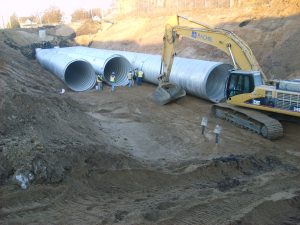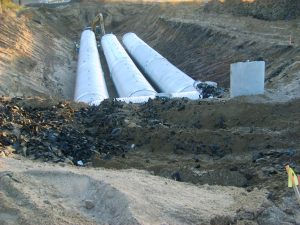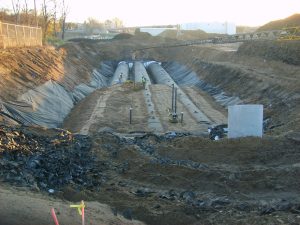
A Historical Transformation
Once the proud home of 3M’s world headquarters from 1910 to 1962, the 46-acre parcel of land on the East side of St. Paul, Minnesota, known as Beacon Bluff, has undergone a remarkable transformation. However, this redevelopment, spearheaded by the Saint Paul Port Authority, presented a significant challenge. They needed to manage stormwater runoff. With the potential for 163 acres of untreated stormwater to flow directly into the Mississippi River, a robust and innovative solution was crucial. This project, now a beacon of sustainable water resource management, stands as one of the largest infiltration projects in Minnesota.
An Underground Giant: The Stormwater Retention System
Engineers designed a colossal underground stormwater retention system to form the heart of Beacon Bluff’s stormwater management strategy. This system features three impressive 162-foot rows of ten-foot diameter aluminized Type 2, 10-gage perforated corrugated steel pipe. The pipes are engineered to last a century. To prevent fine particles from clogging the system, a protective geotextile fabric envelops the pipe. With a capacity to retain up to 264,172 gallons of runoff, this subterranean network significantly mitigates the risk of downstream flooding.

Innovative Design: Shredded Tires for Enhanced Infiltration
Furthermore, the Beacon Bluff project showcases a unique and resourceful approach to stormwater infiltration. Above the compacted engineered fill surrounding the retention pipe, a layer of shredded rubber tires creates additional void space. This ingenious technique allows for greater stormwater infiltration. It also helps in sediment capture. As runoff percolates through the layers of fill and into the retention pipe, contaminants clinging to sediment particles are effectively filtered out. A final layer of two feet of granular sand completes this innovative filtration system.
Sustainability in Action: Recycled Materials and Water Quality Monitoring

The Beacon Bluff project champions sustainability through its innovative design and conscious material choices. The corrugated steel pipes themselves are constructed with up to 95% recycled material. This approach embodies the principles of resource conservation. Moreover, environmental engineers actively monitor the system’s effectiveness. They capture approximately 90 percent of sediment within the stormwater retention system. The sediment collects in a sump designed for periodic removal through strategically placed ports. These engineers also test and track effluent runoff, ensuring compliance with watershed requirements and safeguarding water quality.
Beacon Bluff stands as a testament to sustainable water resource management, showcasing cutting-edge technology and innovative design. By effectively capturing and treating stormwater runoff, this project protects the Mississippi River, enhances the local environment, and provides a model for future developments.
Related Stories
ViaCon Steel Culverts: Saving the Day on Turkey’s Balıkesir-Manisa Road
Project Spotlight: 72 Milton
Taming the Torrent: Sustainable Water Management Solutions for Extreme Weather